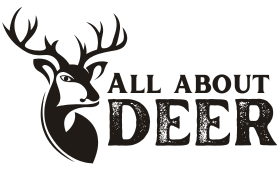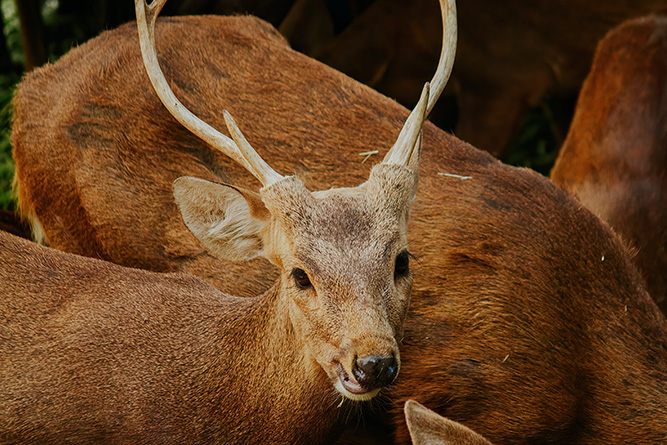Bawean deer, scientifically known as Axis kuhlii, is a species of deer endemic to the island of Bawean in Indonesia. These small-sized deer are characterized by their distinctive markings and short antlers. They primarily feed on leaves, fruits, and grasses, making them herbivores.
Unfortunately, Bawean deer are facing a critical threat to their survival. Habitat loss due to deforestation and hunting activities have pushed this species to the brink of extinction. As a result, they are now classified as critically endangered according to the International Union for Conservation of Nature (IUCN).
Species Data
- Class: Mammalia
- Order: Artiodactyla
- Family: Cervidae
- Scientific Name: Axis kuhlii
- Life Span: Typically 15-20 years
- Height: Approximately 60-70 cm (24-28 inches)
- Weight: Around 25-45 kg (55-99 pounds)
Description
The Bawean deer, scientifically known as Axis kuhlii, is a small to medium-sized deer species endemic to Bawean Island in Indonesia. These deer are characterized by their reddish-brown coat and distinctive white spots on their body. Both males and females typically have unbranched antlers.
Appearance of Bawean Deer
The Bawean deer, also known as the Axis kuhlii or hog deer, has a distinctive appearance that sets it apart from other deer species. Let’s take a closer look at their unique features:
Coat Coloration and White Spots
Bawean deer can be found in various shades of brown, ranging from reddish-brown to grayish-brown. Their coat color helps them blend into their natural habitat, which is often covered in bark, leaves, and vegetation. One interesting feature of these deer is the presence of white spots on their body. These spots are more prominent when they are young but tend to fade as they grow older.
Antlers
Both male and female Bawean deer possess short antlers that measure up to 20 centimeters in length. While the antlers may not be as large or elaborate as those of other deer species, they still serve important purposes for these animals. The antlers are used for defense against predators and during mating rituals.
Slender Body
Bawean deer have slender bodies that allow them to navigate through dense vegetation with ease. This agility is crucial for their survival in their natural habitat. Their slim physique enables them to move swiftly and silently, making it easier for them to escape from potential threats such as large snakes or other predators.
Facial Features
The face of a Bawean deer is adorned with distinct characteristics. They have whitish eyes that stand out against their brown coat, giving them an alert appearance. These keen eyesight aids in detecting danger and finding food sources even during dusk or low-light conditions.
Camouflage Abilities
The coat coloration of Bawean deer serves another purpose besides blending into their surroundings – camouflage. The yellow-brown hues help them remain hidden amidst the foliage and undergrowth where they seek cover from predators or human disturbances.
Size and Weight of Bawean Deer
The Bawean deer, also known as Axis kuhlii, comes in various sizes depending on their gender and age.
Adult Male Bawean Deer Height
Adult male Bawean deer can reach a height at the shoulder between 60 to 70 centimeters. That’s about the same height as an average 5th or 6th grader! These majestic animals stand tall and proud, showcasing their impressive stature in the animal kingdom.
Female Bawean Deer Size
Females tend to be slightly smaller than males in size. While they may not be as towering as their male counterparts, female Bawean deer are still graceful and elegant creatures. They possess their own unique charm that sets them apart from the rest.
Average Weight of Adult Males
On average, adult male Bawean deer weigh around 25 kilograms. That’s equivalent to carrying three large watermelons! These strong and sturdy animals have a solid build that allows them to navigate through their natural habitat with ease.
Average Weight of Females
In comparison to males, females weigh slightly less. On average, adult female Bawean deer weigh around 20 kilograms. That’s about the same weight as two medium-sized dogs! Despite being smaller in size, female Bawean deer are just as resilient and adaptable.
Newborn Fawn Weight
They start off small but grow quickly over time. At birth, these adorable little creatures typically weigh around 1 kilogram. That’s about the same weight as a bag of sugar! As they continue to feed and develop under the watchful eye of their mothers, they gradually gain strength and size.
Habitat and Behavior of Bawean Deer
Bawean deer, also known as Axis kuhlii, have specific preferences. They thrive in lowland rainforests and open grasslands that are close to water sources. These environments provide them with the necessary resources for survival, such as food and water.
During the day, Bawean deer tend to be more inactive and find shelter in dense vegetation or other concealed areas. However, they become mainly active during dawn or dusk when they venture out to feed. This behavior is known as crepuscular activity.
One remarkable characteristic of Bawean deer is their agility. They possess an incredible ability to jump over obstacles that are up to 2 meters high! This exceptional jumping capability allows them to navigate through their habitat effortlessly and escape potential threats.
In terms of social behavior, Bawean deer are generally solitary animals. They prefer a more independent lifestyle rather than living in large herds like some other deer species. However, during the mating season, which typically occurs from October to December, they may form small groups temporarily.
These temporary groups consist of a male (known as a buck) and several females (known as does). The buck will compete with other males for dominance by engaging in displays of strength and aggression. The dominant buck will then mate with the receptive does within his territory.
It’s fascinating how different species adapt differently based on their environment and needs. While some animals thrive in groups, others prefer solitude like the Bawean deer.
Mating Behavior and Reproduction of Bawean Deer
Breeding season for Bawean deer occurs from April to June. During this time, males compete for females by engaging in antler fights. These fights are like battles between bucks, where they lock their antlers and push against each other to establish dominance and win the right to mate with the females.
After a gestation period of around 7 months, females give birth to a single fawn. This means that they only have one offspring at a time. The mother hides the fawn in dense vegetation for protection during its early weeks. She does this to keep it safe from predators and also to keep it hidden from humans or other potential threats.
The process of reproduction in Bawean deer is fascinating. When the female is ready to give birth, she finds a secluded spot in the forest where she feels safe. Once the fawn is born, it is very vulnerable and relies on its mother for survival. The mother takes great care of her young one, providing it with milk and keeping a close watch over it.
Bawean deer have evolved this behavior as a way to protect their offspring from danger. By hiding them away, they increase their chances of survival in their natural habitat. It’s amazing how nature has equipped these animals with instincts that help them ensure the survival of their species.
Captive breeding programs have been established to help conserve the Bawean deer population due to its endangered status. These programs aim to breed these deer in captivity under controlled conditions and then release them into protected areas once they are mature enough.
It’s important for us humans to understand the significance of conserving these animals’ habitats and protecting them from harm. By doing so, we can contribute towards ensuring that future generations get to witness these beautiful creatures thriving in their natural environment.
Threats to Bawean Deer and Conservation Efforts
Habitat loss due to deforestation
One of the biggest threats faced by Bawean deer is habitat loss due to deforestation. This means that their natural homes, which are the upland forests with dense undergrowth, are being destroyed. The clearing of these forests for various purposes, such as agriculture or logging, leaves the deer with fewer places to live and find food.
Illegal hunting for meat and trade
Another significant risk to the population of Bawean deer is illegal hunting for meat and trade. Unfortunately, some people hunt these beautiful creatures for their meat or capture them for illegal trading purposes. This has a detrimental impact on the already endangered population of Bawean deer.
Conservation efforts
To protect this threatened species from further decline, conservation efforts have been put in place. One important step is the establishment of protected areas where these deer can roam freely without disturbance from human activities. These protected areas provide a safe haven for the Bawean deer to thrive and reproduce.
Raising awareness about the endangered status of Bawean deer is another crucial aspect of conservation efforts. By educating local communities and spreading knowledge about the importance of protecting this species, more people become aware of their plight and are motivated to take action.
Collaborative initiatives
Conservation organizations, government agencies, and local communities have come together in collaborative initiatives to protect the Bawean deer. By working together towards a common goal, they can pool resources and expertise to implement effective conservation strategies.
These initiatives involve not only protecting existing habitats but also restoring degraded ones. Efforts are made to replant trees and create new forested areas that mimic the natural environment preferred by Bawean deer.
Predator control measures may be implemented as part of conservation efforts. Natural enemies like wild boars or predators such as pythons can pose a threat to the survival of Bawean deer. By managing the populations of these predators, the chances of survival for the deer can be increased.
In addition to protecting their natural habitats and managing predators, conservationists also attempt to address the issue of habitat loss by promoting sustainable land use practices. For example, instead of clearing forests for teak plantations, alternative methods that allow for coexistence between human activities and wildlife can be explored.
5 Fun Facts About Bawean Deer
- Bawean deer are excellent swimmers and can traverse short distances between neighboring islands.
- They communicate using vocalizations, including soft whistles and grunts.
- The white spots on their bodies help them blend into the dappled sunlight of the forest.
- Bawean Island is their exclusive habitat, making them a true island gem.
- Conservation efforts are crucial to protect these unique deer and their island home.

